"There, peeping among the cloud-wrack above a dark tor high up in the mountains, Sam saw a white star twinkle for a while. The beauty of it smote his heart, as he looked up out of the forsaken land, and hope returned to him. For like a shaft, clear and cold, the thought pierced him that in the end the Shadow was only a small and passing thing: there was light and high beauty for ever beyond its reach." -J.R.R. Tolkien
But over at XKCD, that quote provides little comfort. After all, "for ever" isn't exactly quite right.
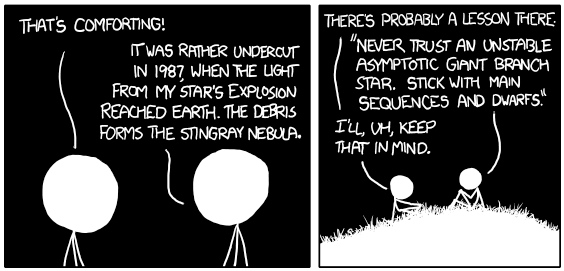
Even the stars must all exhaust their fuel and die.
Right?
Let's head on over to the Constellation Ara, down in the Southern Hemisphere.

Looking close-up at one spot in the sky, you can find a very special star, known to astronomers as Hen 3-1357.
Throughout most of recorded history, it was a star similar to our Sun, only a little more massive -- maybe two or three times as heavy -- and it was headed towards the end of its life.
You see, when a star like the Sun puts out energy, it does so by fusing light elements into heavier ones in its core.
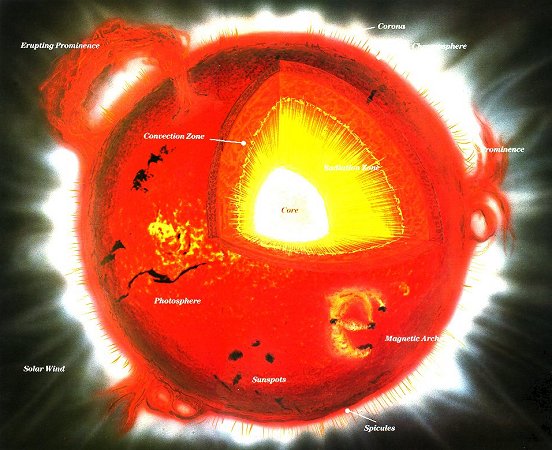
When it runs out of the lightest element, Hydrogen, it starts fusing the next lightest element, Helium, into still heavier ones. And it will keep doing this -- if you can generate enough pressure and temperature -- all the way up until it fuses elements into iron, the most stable of all the elements.

Towards the end of its life, the star becomes a red giant, swelling to many times its normal size.
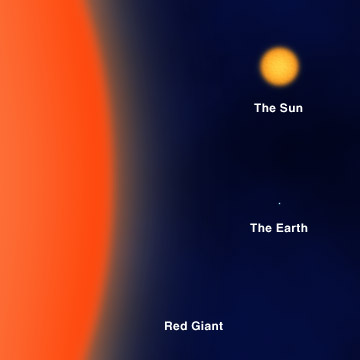
The best known red giant, actually, is your friend Mira, which isn't just a red giant, but is a special type of red giant that lives on the asymptotic giant branch.
These stars, more massive than our Sun (but not so massive that they'll go supernova), actually pulse, and start to blow off their outer layers, which expand incredibly fast and cool down, forming a protoplanetary nebula.
And then it happens. That last bit of burnable fuel gets used up, and that's the end of your star!
Well, kind of. The core of the star contracts, and forms a white dwarf, releasing a large amount of energy. The outer layers get permanently blown off, and create a planetary nebula that gets lit up by the energy released from the inner core's contraction.
This "moment of death" of the star in Ara occurred in 1987, and formed the Stingray Nebula.
Looking at the very interior, we can actually see that there are two stars; this is a binary star system!
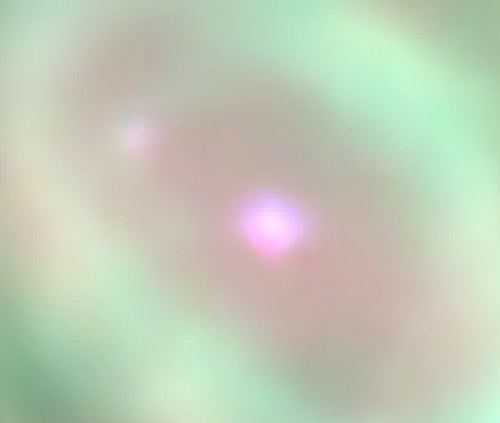
But what's going on at the outside is by far more interesting. This object is way smaller than every other planetary nebula we know about; it's only a few percent of a normal nebula's size!
But you see those "blips" on either side? That look like something is starting to blow the gas outward? That's a glimpse into the future of what this planetary nebula is going to look like!
Rather than a perfectly symmetric nebula, we're likely to wind up with something with a definite preferred axis. Maybe it'll be extreme, like the Boomerang Nebula?

Or maybe it will be a beautiful, intricate pattern lengthened in one direction, like the most photogenic of nebulae, the Cat's Eye Nebula?
Regardless, this isn't so much a death as a transformation. Your 15th magnitude Red Giant from the Asymptotic Giant Branch isn't gone so much as it's blowing off its outer layers and evolving into a white dwarf.
Kind of similar to...

...a caterpillar morphing into a butterfly!
So it isn't really "death" at all, it's simply the next stage of this star's life cycle. And if we started with Lord of the Rings, it's only fitting to end it the same way.
Pippin: I didn't think it would end this way.
Gandalf: End? No, the journey doesn't end here. Death is just another path, one that we all must take. The grey rain-curtain of this world rolls back, and all turns to silver glass, and then you see it.
Pippin: What? Gandalf? See what?
Gandalf: White shores, and beyond, a far green country under a swift sunrise.
Pippin: Well, that isn't so bad.
Gandalf: No. No, it isn't.

This is going to change quickly, so let's make sure to look back in a few years, and see what the Stingray Nebula becomes!
- Log in to post comments

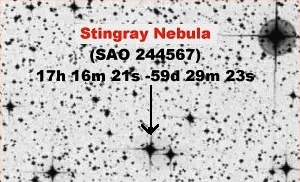
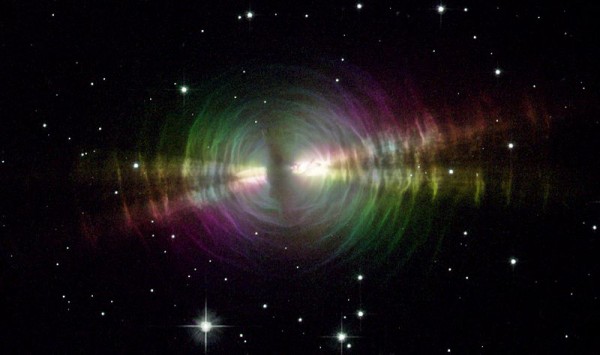


Ha, astronomy AND Lord of the Rings? This post just made my day. :3
Not to disrespect Gandalf but who needs an afterlife with things as cool as Hubble in this life.
Ethan;
Thank you for an interesting article and insightful explaination to the beginings of the Stingray Nebula. With the secondary star, would it be absorbing matter out of the nebula because of gravity? It will be interesting to see how the nebula evolves over time and the effect of the secondary star.
Thank you;
--Jerry
Excellent read, thanks.
However, as usual with articles of this nature, I found confusing tense usage on this page: surely the thing we are looking forward to is, to see "what the Stingray Nebula has become" not "what the Stingray Nebula becomes" and "how the nebula has evolved", not "how it will evolve"?
It also seems wrong to be saying that Ara's "moment of death occurred in 1987" - this moment of death occurred in about 16,000 BC, a fairly long time prior to our observation in 1987 of the event.
Vince, oh, Vince, are you a new reader?
Ethan wrote his argument about this only a couple of months ago (I think); it involves light cones and the lack of a non-subjective viewing point anywhere within the universe. It seems there's a big debate on the issue but professional astronomers lean towards treating things seen in the now as happening in the now. Check the archinves and read up.
Thank you for the wonderful explanation! You have a nice re-interpretation of that XKCD. :)
That was a brilliant piece, I love your illustrations also and no blog post is complete with a reference to Gandalf and the LOTRs
So, assuming the remaining star in the binary system is somewhat more sun-like and has a couple billion years left to go, will that nebula slowly condense into planets, with other words, are we witnessing the birth of a new solar system?
But Samantha, I don't need a non-subjective viewing point: from my subjective viewing point, if I see light from a source that is 16,000 light-years away, basic high school physics tells me that what I am seeing happened that far in the past. In fact, the idea that this light represents the "present" would imply the viewer believes in some sort of magical non-subjective viewing point which exists outside the laws of physics. Maybe I'm the one suffering imagination-failure, but this has bugged me for years.
Thank you very much for this information to you dear, and the authors of the site administrators
Blended scope once again! Continue earning that No.1 spot, no resting on laurels here. What a nice way of explaining that without the "death of stars" we could never be, and yet with that death comes great beauty also. Dare I say it, "the great (cosmic) circle of existence"?
You should cite the source for "redshift.gif":
http://www.astro.ucla.edu/~wright/doppler.htm
You've got it, Ned! Right here: http://scienceblogs.com/startswithabang/2011/01/the_telescopes_best_fri…
Thanks for catching that!
So, are white dwarfs orbs of hot iron?
Can't slip one by ole' Ned Wright. He's always watching...always.
I find it pretty cool that Dr. Wright is a regular reader/poster to the blogs (even if mostly to check your works cited). I had no idea he was as heavily involved in cosmology as he is until I finally decided to find out more about this guy who's graphs you frequently use. You should see if Dr. Write would be kind enough to do a guest write up sometime in the future.
Good question glaisne : you are actually pointing to an inaccuracy of this otherwise nice post... As Ethan writes, a star fuses elements up to iron "if you can generate enough pressure and temperature". However a star that will become a white dwarf is not massive enough to generate such temperatures : it thus stops the fusion process at some earlier stage. The lowest mass stars are not able to fuse Helium and leave behind a white dwarf made of Helium. At higher mass, stars become a white dwarf made of oxygen or carbon. The production of iron is possible only at still higher masses (about 10 solar masses). These very massive stars "end their life" in a much more violent explosion than the protoplanetary nebula described here: they produce a powerful explosion called a supernova. Even though more violent (the star can lose most of its mass in the explosion), this event is also not so much a death as a transformation. In the process the star becomes an object more massive and more compact than a white dwarf: either a neutron star or a black hole...